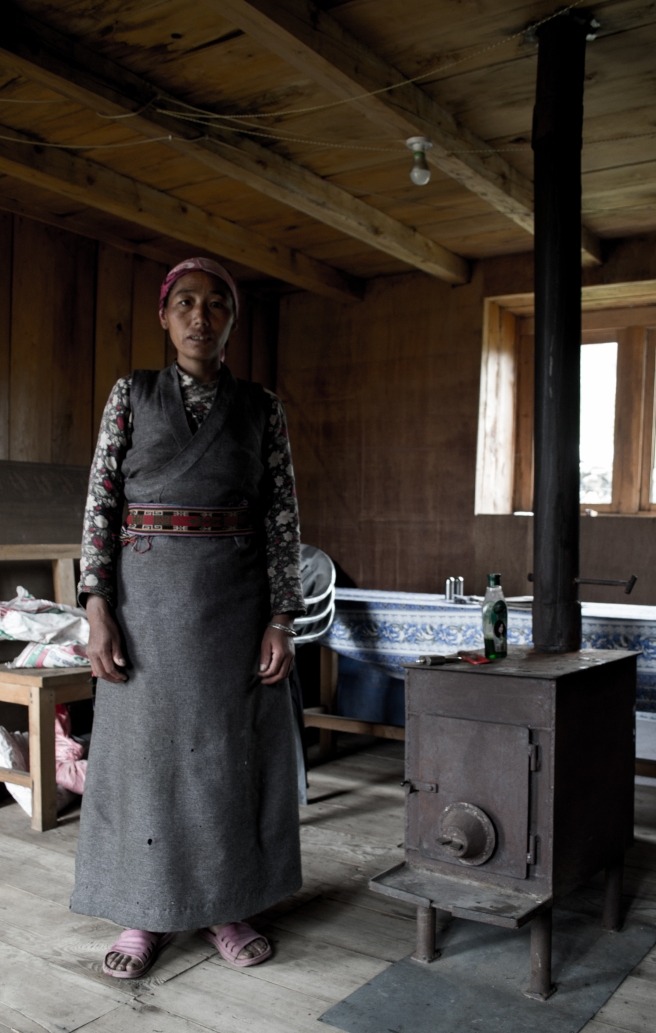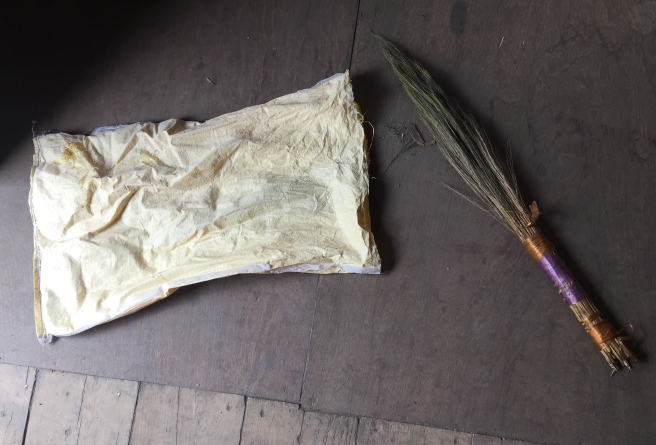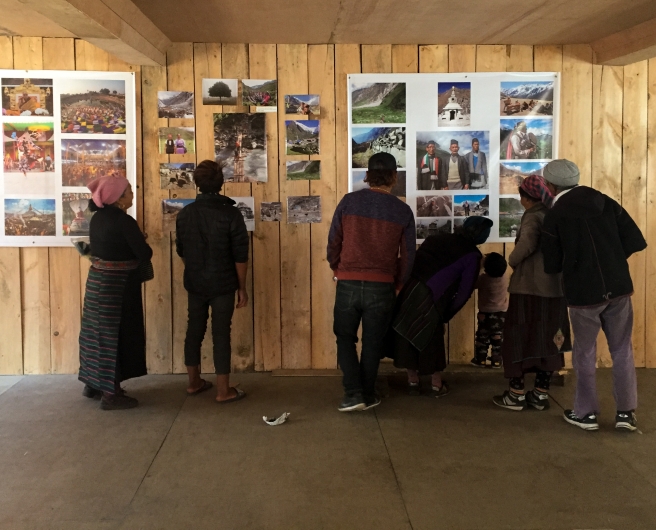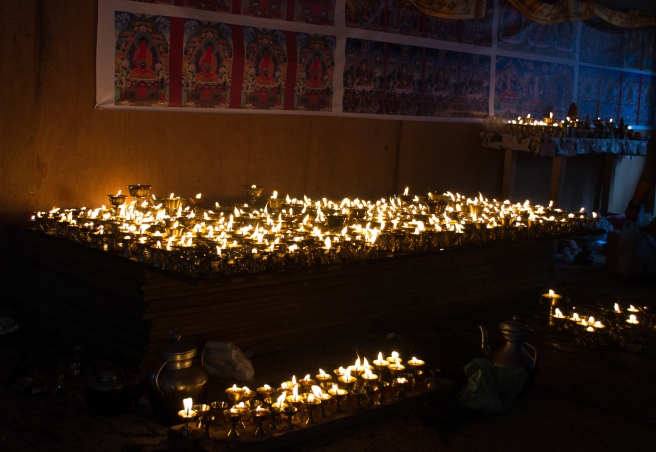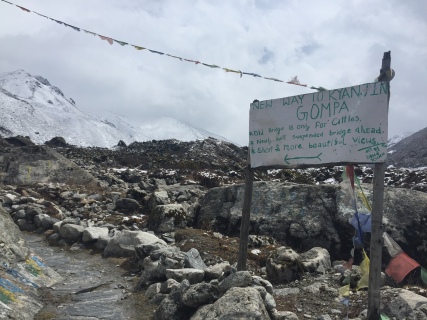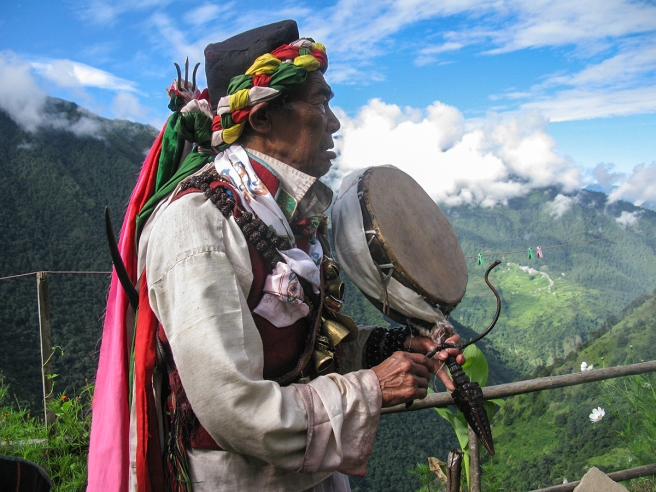I walked out of Pemba’s house and made my way toward the mani walls dividing the dirt path of Mundu Village. I was thinking about these walls, looking at the mani stones, wondering whose hands had carved the intricate Tibetan letters hundreds of years ago. Wondering whose hands had placed these stones in the current structure of the wall after the earthquake had knocked them down.

“Chori!” [“Daughter!”]¹
I looked up. I knew the word had been directed at me because the speaker was communicating in the Nepali language. The Langtangpas speak to each other in a language closely related to the dialect of Tibetan spoken in Kyirong, belying the community’s ancestral origins from Tibet. Prior to the opening of Nepal’s borders to outsiders in 1951 and the creation of the Langtang National Park in 1976, ‘non-Langtangpas’ rarely entered the Langtang Valley, lending legitimacy to the reference of the Langtang Valley as a ‘beyul’. ‘Beyul’ is a Tibetan term that can be understood in terms of ‘sacred geography’ and ‘a place of refuge’ in the form of ‘hidden valleys’ within the Himalayan mountains. In these ‘hidden valleys’, it was believed to be possible to replicate “an ideal model of Tibetan political organization . . . when facing the threat of social disintegration (Lim 33).”
Thus, the inhabitants of the Langtang Valley perceive themselves and their homeland as sacred–a concept contradictory to the circumstances that the Langtangpas have been facing following the creation of the Langtang National Park. These circumstances, largely out of the control of the Langtangpas themselves, have caused a sharp transition in livelihood from the traditional reliance on subsistence agriculture, animal husbandry, and trading systems, into a reliance on the tourism industry subjecting the Langtangpas to larger surveillance and regulation by the Nepalese state.
“Chori, mero photo kichdinu!” [“Daughter, take my photo!”]
I smiled at the man’s request. Placing my backpack on the ground and taking out my camera, I looked at the face of the man, Wang, referring to me as daughter. We had not spoken before, and so I asked him where he lived within the valley. He informed me that he is a yakherder, living a lifestyle that ties him to the schedule of his cattle. Wang said he cannot leave his animals and so he cannot travel to Kathmandu or even to Dunche—a town further down the mountain within the same district. He requested me again to take his photo and to bring it back once I return again to Langtang.
“Hus Ba,”[Okay, Ba²,”] I laughed. “Huncha, ma tapaiko photo kichdinchu ani pachi lederaunchu,..” [Okay, I will take your photo and later I will bring it back to you..”] I replied.
I wondered to myself how many people had taken his photo before with no intention of giving him a copy, no ability to ask permission in a language that Wang would be able to reply to. I looked through the camera, pointing it in his direction.
“Ek chin, Chori!” [“Just a minute, Daughter!”] he exclaimed.
I pulled the camera down from my face and watched as he straightened his jacket over his shirt and placed the plastic tube that he had been using as a walking stick on the ground. I thought again about the countless times that tourists must have photographed Wang and others like him in Langtang. These innocent intentions to capture the ‘traditional lifestyle’ of the locals now seemed like stolen images. I waited with the camera at my side.
“La. Kichdinu, Chori.”[“Okay, take the photo, daughter.”]
I smiled and pointed the camera at him once again. He stood stiffly on the dirt path, looking in my direction.
“La, Chori. Pachi lederaunu. Tapai ramro mancha. La, bye Chori.” [“Okay, Daughter. Bring it back with you later. You are a good person. Okay, bye, Daughter.”]
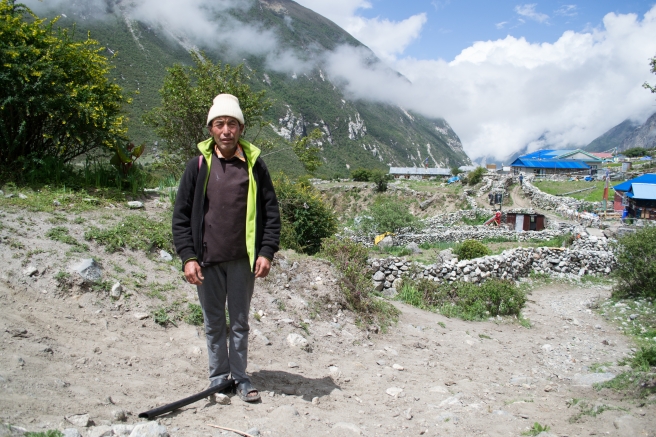
Upon returning to Langtang a few weeks later:
The clouds hung low as I walked from Mundu Village to Kyanjin Gumba—the final ‘formal village’ of the Langtang Valley. Drops of rain were slowly falling from the sky. I found my umbrella, and made my way from the large hotels of Kyanjin Gumba to the goths located about 30 minutes away. A goth is a temporary ‘herding hut’ that the yakherders live in while their yaks and other cattle graze that area. In the past, specifically prior to the influx of the tourism industry, Langtangpas supplemented their agriculture and animal husbandry practices with trade, creating a network between southern Tibet and central Nepal. Francis Lim writes, “Owning a large herd of crossbreeds used to be considered a source of prestige for the Langtangpa, but villagers these days view running a hotel business as the means to a better life and social status. This shift in status symbolism and aspiration is the direct result of the arrival of trekking tourism in the area (74).”

In addition to the creation of the National Park, the Nepalese government also started a Cheese Factory in the valley, further bringing the Langtangpas into contact with outsiders. Tom Cox wrote in 1985 that “the cheese factory has been partially responsible for bringing the Langtang people more into the cultural, political and economic mainstream of Nepal (68).” The Cheese Factory altered trading systems that were in place and put the Langtangpas in contact with the Nepali language and Nepali education system. Cox writes about these factors as helping to “undermine the traditional Tibetan culture of Langtang (68).” Nowadays, the Langtangpas , like Wang, who continue the yakherding tradition are much fewer, a phenomenon that reflects the transition of power to the hotel business and tourism industry.

I could see two of these temporary houses in the distance as I made my way further from the tourist hub of Kyanjin Gumba. As I gripped the photo in my hand, I wondered if I would be able to find Wang. It had been almost a month and I wasn’t sure where he was staying at the time. As I got closer, I saw a man’s head appear from the structure. I recognized the smile even from a distance.
“Chori, tapaile aunubhayo!” [“Daughter, you came!”]

“Tashi Delek, Ba!” I greeted him with the appropriate Tibetan greeting, smiled and handed him the photo I had taken a few weeks ago. He spoke to me as if he had been expecting me to show up. After a few minutes of examining the photo together, he brought it inside of his goth and told me to wait while he prepared Tibetan tea.

Tibetan tea is made from nak milk, butter, tea leaves, and salt. (‘Nak’ means ‘female yak’ in Nepali.) We sat next to the fire on the ground of the goth as he poured the Tibetan tea. He told me that he was storing the photo I had given him in one of the cracks between the rocks of the goth walls because no rain water reached there. I listened to him as he talked about what life as a yakherder in Langtang is like. He picked up his ‘spinning mani’ and began to spin it gently as we continued our conversation. He explained that the yakherders mostly sell the milk for use at the Cheese Factory. The factory had been destroyed in the earthquake of 2015 and was recently rebuilt. For one liter of ‘high fat content milk’, meaning 7-8% fat, a yakherder is given 250 Nepali Rupees.

Wang told me about his puja practices–a Buddhist ritual. Each time that he and the other yakherders in his group change spaces, a puja must be done for preventative purposes. A ‘kharka’ is the ‘herding camp’ or the different grazing areas that the yakherders rotate their animals on. The yakherders change kharkas every 8 to 9 days and once they arrive in the next area, the yakherder performs a puja so that the yaks do not become sick or break their horns. Wang also talked about the belief that the yakherder’s fingers may not work if these pujas are not performed
He continued to spin the mani.

He then began to tell me about the puja he performs each morning. It is common for a Langtangpa member of each household to perform a daily puja in the mornings. This puja is a way of praying for and blessing the people in his life. He prays for the other villagers, for himself, for his family, and his friends. He even prays for the tourists he encounters. Wang explained to me his perception of tourists and the power that lies in these ‘outsiders’. He explained that in some aspects, tourists are like ‘gods’, referring to the support that some foreigners provide via the tourist industry financially and through sponsorship of their children’s education. Without these sponsorships, many Langtangpa children would not be able to attend school in Kathmandu, where the best opportunities for education are available in Nepal.
However, Wang explained to me that many tourists also come to Langtang knowing nothing about the local customs. Some pitch their tents in the places where people have died, some come with meat and eat in sacred places like the base camp at Langtang Lirung, and some do not properly clean up after themselves. Wang said to me that this is not the fault of the tourists, rather it is a lack of local knowledge on their part. But this also means that the traditions and customs of living in this ‘beyul’ are not being followed. This is why Wang and many other Langtangpas believe that they must pray for the tourists during their puja rituals. This ‘disrespect’ to the sacred geography of Langtang is often listed among many other ‘local knowledge’ reasons for the big avalanche in Langtang Village that accompanied the earthquake of 2015.
Between sips of the heavy Tibetan butter tea and in the quiet spaces between our conversation, I looked around—a place to sleep and a place to cook, a place to perform his puja rituals, and some hay for the animals that he kept under the shelter with him. I remembered our conversation from a few weeks ago when Wang had stopped me on the trail in Mundu. I remembered when he told me he was a yakherder and he was not able to travel outside of the valley in order to get his photo taken, to print photos.
I wondered what he thinks about me, the foreign girl who can communicate with him in his second language, the girl that he affectionately refers to as ‘chori’. My interactions with Wang illuminated parts of a different side of Langtang for me, parts not so directly related to the tourism industry. The yakherders hold a place within the community that reaches into the deeper history of the community. Wang explained that the future of yakherding seems to be dwindling in Langtang. The younger generation is not accustomed to the lifestyle. He believes that soon, after his generation of yakherders becomes too old, that his cattle will just be left to live in the jungle. This perception of the future is indicative of the circumstances that have been changing rapidly in Langtang, the new standards of cleanliness and the new hopes associated with education for the younger generations.
It has been, and continues to be, a privilege to participate in conversations such as these. Thank you for reading as I continue to learn and share.
Jennifer
¹It is common for older people in Nepal to refer to younger women in kinship terms, such as chori (daughter) or bahini (younger sister).
²Ba is a term that literally means ‘father’, but is used as a form of respect when speaking to older men.
References
Cox, Tom. “Herding and Socio-economic Change Among Langtang Tibetans.” CNAS Journal. 1985.
Lim, Francis. “Imagining the Good Life: Negotiating Culture and Development in Nepal Himalaya.” Brill: Leiden, 2008.







